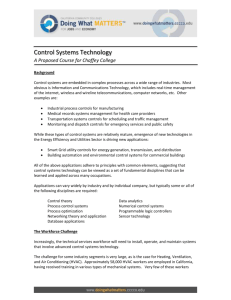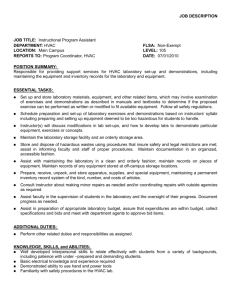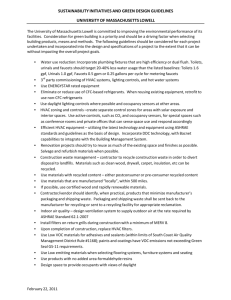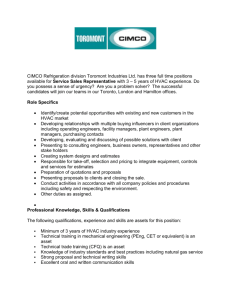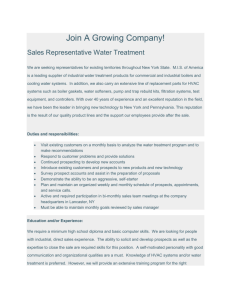High-Performance Building Operations Professionals
advertisement
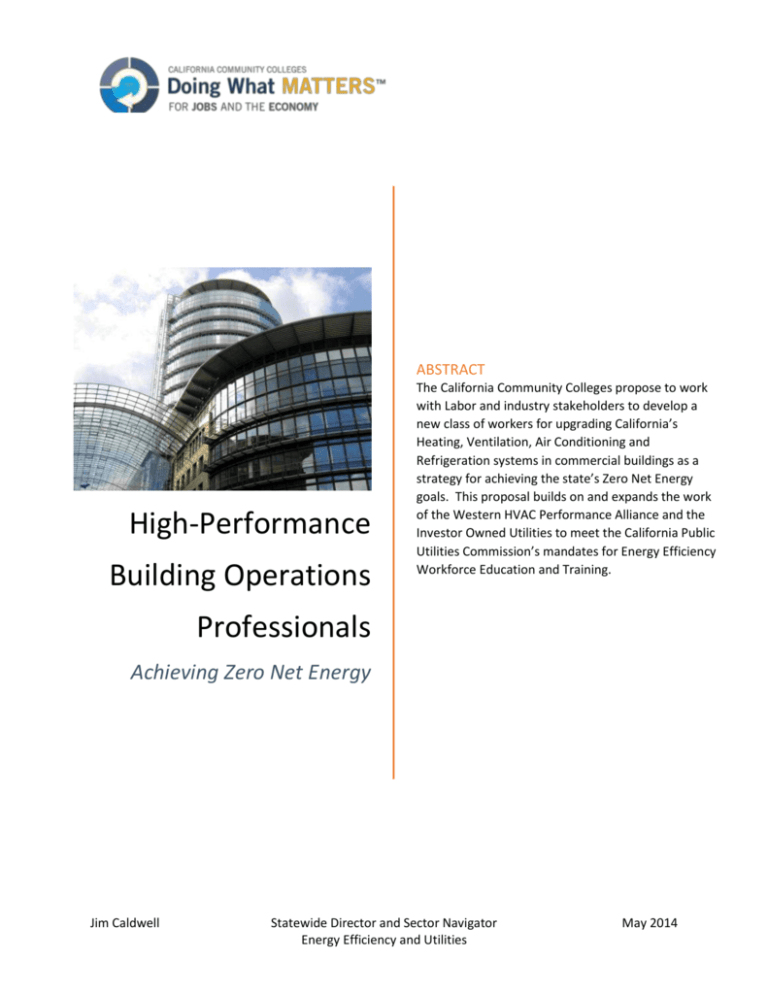
ABSTRACT High-Performance Building Operations The California Community Colleges propose to work with Labor and industry stakeholders to develop a new class of workers for upgrading California’s Heating, Ventilation, Air Conditioning and Refrigeration systems in commercial buildings as a strategy for achieving the state’s Zero Net Energy goals. This proposal builds on and expands the work of the Western HVAC Performance Alliance and the Investor Owned Utilities to meet the California Public Utilities Commission’s mandates for Energy Efficiency Workforce Education and Training. Professionals Achieving Zero Net Energy Jim Caldwell Statewide Director and Sector Navigator Energy Efficiency and Utilities May 2014 HIGH-PERFORMANCE BUILDING OPERATIONS PROFESSIONALS Table of Contents Executive Summary....................................................................................................................................... 2 The Zero Net Energy Challenge ..................................................................................................................... 3 The HVAC Quality Installation/Maintenance Challenge ............................................................................... 4 The Workforce Pipeline Challenge ................................................................................................................ 6 The Incumbent Workforce Challenge ........................................................................................................... 6 The Long-Term Workforce Challenge ........................................................................................................... 8 A Strategic Approach .................................................................................................................................. 10 Proposed Solution ....................................................................................................................................... 11 Project Plan ................................................................................................................................................. 16 Deliverables and Timeline ........................................................................................................................... 19 Budget ......................................................................................................................................................... 20 Appendix A .................................................................................................................................................. 21 FEBRUARY 2014 1 HIGH-PERFORMANCE BUILDING OPERATIONS PROFESSIONALS Executive Summary Commercial buildings consume more electricity than any other sector in California, constituting 38 percent of the state’s power use and over 25 percent of natural gas consumption. Meeting the state’s Zero Net Energy mandates (Assembly Bill 758) is a significant challenge, with Heating, Ventilation, and Air Conditioning (HVAC) as a major source of potential energy savings. The California Long Term Strategic Energy Efficiency Plan states that 100% of HVAC systems would be installed to quality standards and optimally maintained throughout their useful life by 2020, with HVAC-related permits obtained for 50 percent of installations by 2015 and 90 percent or more by 2020 (CPUC 2008). Pressures on California’s HVAC workforce are high, as a very large percentage of the state’s 58,000 incumbent workers1 are not trained in energy efficiency, and many of those trained have difficulty keeping up with changes in technology, codes, and standards. Further, more than 2,0001 will leave the HVAC workforce annually, presenting a significant gap in a growing market. Based on research by the Western HVAC Performance Alliance2 (WHPA), Lawrence Berkeley National Laboratories, and others, this proposal identifies key workforce gaps to be filled in order to meet the 2020 Zero Net Energy mandates. The California Community Colleges propose to develop, in two phases, curriculum and pilot training for up-skilling incumbent workers, informing curriculum in postsecondary career pathways, engagement with key stakeholders, and a proposal for a lattice of career pathways supported by a structure of certification and accreditation. A plan for phase 3 will be developed, which if funded, will scale the program across the state. Phases 1 and 2 will be completed in twelve months with funding from the National Science Foundation, the California Community Colleges, and others led by the Investor Owned Utilities. 1 2 California Community Colleges Centers of Excellence, January 2014 www.performancealliance.org FEBRUARY 2014 2 HIGH-PERFORMANCE BUILDING OPERATIONS PROFESSIONALS The Zero Net Energy Challenge Commercial buildings consume more electricity than any other sector in California, constituting 38 percent of the state’s power use and over 25 percent of natural gas consumption3. Given the large portion of energy use that comes from this sector, commercial buildings are the focus of several state policies focused on substantially reducing building energy usage within this sector. AB 7584 requires the CEC and CPUC to create and implement a comprehensive retrofit program for existing buildings through targeted development of workforce and training infrastructure; transformation of energy assessment, retrofit, and finance markets, and requirements for energy ratings and upgrades. Specifically, the CEC’s AB 758 Scoping Plan outlines the challenge in meeting the California Zero Net Energy goals for commercial buildings through this graphic representation5: Effective implementation of AB 758 is fundamentally important to California’s energy policy: there is no realistic path to achieving the state's aggressive energy efficiency targets and carbon emissions goals without accomplishing large-scale improvements to the existing building stock3. The IOUs are responsible for implementing energy efficiency programs and the CPUC’s Energy Division (ED) is responsible for overseeing and evaluating these activities to inform future policy direction, improve program design, and refine savings estimates. 3 California Public Utilities Commission, 2010 – 2011 Energy Efficiency Annual Progress Evaluation Report, September 2012 4 http://www.energy.ca.gov/ab758/ 5 California Energy Commission, Staff Report: COMPREHENSIVE ENERGYEFFICIENCY PROGRAM FOR EXISTING BUILDINGS SCOPING REPORT, August 2012 FEBRUARY 2014 3 HIGH-PERFORMANCE BUILDING OPERATIONS PROFESSIONALS Despite policy objectives encouraging comprehensive, long-term energy savings projects (e.g. approaches that offer customers suites of efficiency measures rather than single technology rebates) many projects in the nonresidential sector continue to focus on short term payback and “shallow” savings6. The California Public Utilities Commission’s (CPUC’s) Energy Efficiency Annual Progress and Evaluation report summarizes the implementation of California’s investor-owned utilities’ (IOUs’) 2010 – 2012 energy efficiency portfolio, based on the best available information from ongoing evaluation studies. The snapshot below illustrates the current gap between projected and realized commercial energy sector savings5: Commercial Energy Sector Savings Snapshot 2011-12 Projected Reported % of Projected kW 588,065 413,783 70% kWh 2,937,172,382 2,111,239,882 72% Therms 38,556,286 22,715,521 59% Overall economic activity, as measured by GDP, is a key determinant of commercial sector growth, and, in turn, commercial floor space growth. From 1980 to 2005, GDP doubled in real terms from $5.8 trillion to $12.4 trillion as measured in constant year 2005 dollars. Consequently, though not perfectly correlated, the absolute amount of commercial floor-space (as measured in square feet) grew by roughly 50 percent over this same period.7 Contractors who comply with HVAC code provisions incur higher costs that are difficult to pass onto customers in a highly competitive market. Such contractors may also experience delays due to local government permit timelines. Local building officials may not have the resources or knowledge to establish streamlined permitting systems to support quality HVAC installations or penalize contractors who do not comply3. The outlook for meeting California’s Zero Net Energy goals is not good. Significant new initiatives may be required to overcome current shortfall in commercial energy sector savings, continuing growth of the state’s commercial building stock, and market adoption barriers experienced by code-compliant contractors. The 2013 update to Title 24 code for energy efficiency in buildings is expected to help close this gap, although it is too early to assess the impact of this code change. The HVAC Quality Installation/Maintenance Challenge Poor installation and maintenance of residential and commercial heating, ventilation, and air conditioning (HVAC) systems is a widespread problem. The California Energy Commission estimates that up to 50% of new HVAC systems and up to 85% of replacement systems are not installed and maintained to a quality level of specification. Given the high potential savings associated with improving 6 California Public Utilities Commission: 2010 – 2011 Energy Efficiency Annual Progress Evaluation Report, September 2012 7 US Department of Energy, Energy Efficiency & Renewability: Energy Efficiency Trends in Residential and Commercial Buildings, October 2008 FEBRUARY 2014 4 HIGH-PERFORMANCE BUILDING OPERATIONS PROFESSIONALS residential and commercial installation and maintenance practices, the CPUC set targets to improve HVAC performance by 50% by 2020 and 75% by 20308. The California Long-range Energy Efficiency Strategic Plan states that quality installation and maintenance should become the industry and market norm (CPUC 2008). More specifically, this goal states that 100% of HVAC systems would be installed to quality standards and optimally maintained throughout their useful life by 2020, with HVAC-related permits obtained for 50 percent of installations by 2015 and 90 percent or more by 2020 (CPUC 2008). This would reduce overall energy use and lower energy costs.9 The HVAC industry has struggled to provide qualified technicians, and market conditions rarely value quality installation and maintenance (QI/QM). Less than 10 percent of HVAC systems obtain legally required pre-installation local building permits and 30-50 percent of new central air conditioning systems are not being properly installed. As a result, Californians pay a large price for the lack of quality installation and maintenance, with commensurate poor performance. The factors that have led to a 2030 percent increase in the peak energy needed to provide consumers with the cooling and comfort they demand on hot summer afternoons has been accompanied by an estimated 30 percent increase in carbon emissionsi. At Southern California Edison’s request, Energy Market Innovations Inc. performed Phase I of a comprehensive training needs assessment for the HVAC Workforce Education and Training Program6. The objective of Phase I was to: (1) document the types of HVAC-related roles that exist within both commercial and residential segments at all levels of the value chain, and (2) understand what skills are needed from multiple stakeholder viewpoints (Edison, industry experts, employers, and employees) for 20 key roles (Technician, Installer, Sales Representative, etc.) throughout all levels of the value chain. This needs assessment provided a number of recommendations, summarized as follows: 1. The Investor Owned Utilities (IOUs), in collaboration with HVAC industry stakeholders, need to agree on the basic foundational set of HVAC requirements for all roles and sectors, and also define a basic set of skills required for specific HVAC roles, accounting for sector differences as warranted. These shared definitions will provide the basis to improve consistency in teaching practices among trade schools, community colleges, four-year colleges and universities, utility training courses and union training courses. From there, the HVAC basics could be applied and through on-the-job training and union apprentices, and evaluated through industry certification. 2. Distinctions among HVAC sectors must be defined in order for the industry to develop a consistently used set of criteria to define the HVAC sectors and the types of equipment employed in each of them in order to communicate the requirements of each sector and therefore promote consistency in HVAC training. 8 Energy Market Innovations, Inc., HVAC Educational Needs Assessment, submitted to Southern California Edison August 2012 9 Harvey, Constance, Energy Efficiency Center, UC Davis: BEST PRACTICES IN SMALL COMMERCIAL HVAC PROGRAMS AT CALIFORINA UTILITIES, March 2013 FEBRUARY 2014 5 HIGH-PERFORMANCE BUILDING OPERATIONS PROFESSIONALS 3. The industry has an opportunity to address market demand issues by coordinating marketing and rebate mechanisms with Workforce Education and Training (WE&T) programs that help HVAC workers sell higher-efficiency products. The IOUs should work internally to coordinate marketing campaigns that promote the need and cost effectiveness of high-quality HVAC installation and maintenance with educational campaigns for HVAC workers. The training strategy should include teaching HVAC workers how to identify energy efficiency upgrades, calculate energy savings and demonstrate the business value of efficiency to customers. 4. The IOUs should collaborate with other industry players to (1) develop trainings that raise the bar on basic HVAC knowledge and skills with identifying Energy Efficiency Reduction Measures, (2) sponsor on-line and in-person classes that help supplement the teaching of basic HVAC skills—such as electrical and energy compliance—to all roles, particularly contractors, technicians, building inspectors, HERS raters, and energy managers, (3) ensure proper sizing is embraced throughout the HVAC value chain through HVAC worker trainings and customer education campaigns, and (4) support apprenticeship and mentoring learning models to help people in the 20 key roles apply knowledge and skills learned in class to real-life situations on the job. The Workforce Pipeline Challenge The U.S. Department of Labor has predicted that the market for heating, air conditioning, and refrigeration mechanics and installers will grow 34 percent between 2010 and 2020, a rate much faster than the average of all occupations. If accurate, that’s over 90,000 jobs in those specialties alone and, if extrapolated to all jobs in the industry, we face countless more vacancies that will need to be filled just to keep pace with attrition and expansion. It’s obvious the current rate of graduates from technical schools, colleges, and apprenticeship programs will be unable to fulfill the demand10. From 2013 through 2016, more than 6,000 job openings are expected for the four primary HVAC occupations responsible for field installation and maintenance in California11: Heating, Air Conditioning and Refrigeration Mechanics and Installers Construction and Building Inspectors Sheet Metal Workers Stationary Engineers and Boiler Operators The Incumbent Workforce Challenge 10 Frendberg, Don, Workforce Development: A Call to Action, The Air Conditioning Heating and Refrigeration News, September 9, 2013 11 California Community Colleges Centers of Excellence, January 2014 FEBRUARY 2014 6 HIGH-PERFORMANCE BUILDING OPERATIONS PROFESSIONALS California now employs more than 58,000 workers8 in the four HVAC occupational categories cited in the previous section. Given the size of the workforce, the industry faces an enormous challenge if it is to raise HVAC performance levels above the California Energy Commission’s estimate that up to 50% of new systems and up to 85% of replacement systems are not installed and maintained to a quality level of specification. In December 2013, the Western HVAC Performance Alliance (WHPA) approved the recommendations of the Commercial QI/QM Working Group within its Workforce Education and Training Committee12. These recommendations answered four questions, summarized below: Where are we today with regard to WE&T Commercial QI/QM? Only a few contractors and technicians are highly skilled and qualified to perform quality performance work. There is a lack of continuity and coordination in building design, construction, installation, maintenance, and service. Most buildings do not have a baseline measurement of current HVAC performance or energy consumption to compare against for the impact of efficiency improvements. Where do we need to be compliant with Net Zero Energy by 2020? All workers need to understand quality workmanship in building performance. All commercial buildings need to be evaluated for their energy performance levels and upgraded in order to improve site energy use intensity that can move it towards achieving Net Zero Energy. Buildings must be maintained and serviced according to best practices for Quality Maintenance to maintain building peak performance. Buildings’ energy performance will need to be measured using standardized criteria throughout the service and maintenance cycle. Quality diagnostic tools must be used properly in order to gather accurate measurement data on building air flow, water flow, amperages, watt usage, etc. The building performance program needs to have some enforcement capabilities to drive building owners to get the needed work done and to force workers to perform quality work. What are the gaps between where we are today and where we need to be in 2020? New HVACR technicians need a career preparation education and training program that provides consistent training. There is a lack of continuity and coordination in building design, construction, installation, maintenance, and service. There are sufficient continuing education and training programs available for HVAC installers, technicians and building operators, but they do not avail themselves to learn what they need in order to do quality workmanship. High quality industry certifications, as identified in the WHPA Certification Working Group Report, are voluntary programs, not required. How can we fill those gaps? 12 Western HVAC Performance Alliance, Goal 2.3 & 2.4 WHPA Commercial QI/QM Working Group Gaps Report, December 2013 FEBRUARY 2014 7 HIGH-PERFORMANCE BUILDING OPERATIONS PROFESSIONALS A higher standard or higher level of workforce capabilities needs to be established through adequate training so everybody is addressing the same set of guidelines that meets AB 758 statewide goals in a cohesive manner. One flow chart or chain through sequenced steps of design, construction, installation, inspection, maintenance, and service (with sign offs at each step) needs to be established in order to get all the players working together to achieve the best system performance and hold all parties accountable throughout the process. The start-up technician is the quality assurance person who catches anything that was missed by the engineers, architects, or the installing technicians.) Establish design teams that get the contractor and the operating personnel for the equipment involved at the front end. Establish protocols for how to measure current energy performance and how to measure energy improvements after work is done, in order to provide a clearer picture of energy savings. When a new building is commissioned, there needs to be a test start-up assessment of the building’s performance against efforts in meeting Net Zero Energy standards of the building. As recommended in a study out of the University of California, Berkeley13, there needs to be a ladder that skilled workers who enter the construction trades can climb, with different certifications required at each level. Establish forms of leverage to incentivize quality workmanship and certification of technicians. The Long-Term Workforce Challenge Many indicators point to the emergence of a new generation of HVAC/R professionals. New technologies, codes, and standards are changing the work. Retirement and attrition require a robust pipeline of new workers. California’s energy savings and carbon reduction goals call for new competencies in data analysis and system-level building performance management. New thinking about “sector strategies” involves the entire value chain – from building owners to manufacturers to the trades – in strategic workforce development. But California’s current workforce education and training systems are not well suited to support this emergence. As referenced in the previous section, there needs to be a ladder that skilled workers entering the construction trades can climb, with different certifications at each level. Actually, there needs to be a career “lattice” with multiple entry points, opportunities for continuous career development, and a range of career targets that can reached be reached by combinations of vertical and horizontal pathways through the lattice. A wide spectrum comprises the HVAC value chain, with many target occupations as shown (among others) in the diagram14 below. Constructing a lattice of pathways into these occupations is a clear 13 “California Workforce Education & Training Needs Assessment.” Donald Vial Center on Employment In The Green Economy Institute for Research on Labor and Employment, University of California, Berkeley. 2011. 14 Charles Goldman, Merrian C. Fuller and Elizabeth Stuart of Lawrence Berkeley National Laboratory; Jane S. Peters, Marjorie McRae, Nathaniel Albers, Susan Lutzenhiser and Mersiha Spahic of Research Into Action, Inc., Energy Efficiency Services Sector: Workforce Size and Expectations for Growth, September 2010 FEBRUARY 2014 8 HIGH-PERFORMANCE BUILDING OPERATIONS PROFESSIONALS priority to be addressed by the California Community Colleges. These pathways will need to support individual career aspirations as well as changes in knowledge, skills, and abilities, labor market demand and employer recruiting criteria. A major objective of the lattice structure is to create pathways that lead to third party credentials in collaboration with industry and to continuously synchronize the course offerings with workforce demand. Lattices include a strong emphasis on stackable credentials that are recognized by employers and enable workers to continue their professional development over the full span of their careers. Currently, a number of industry-recognized credentials exist at the highest competencies, such as NATE and Building Operator Certification. Lower level certification is much less structured, creating uncertainty among employers and ambiguous career pathways for students and workers. Long-term workforce development entails a comprehensive strategy to bridge the gaps between where our HVAC workforce is today and where it needs to be in 2020 and beyond. Briefly, the gaps that the WHPA Certification Working Group identified are15: Gap 1 - No Career Lattice for the HVACR industry Gap 2 - No Statewide Technician Certification Database Gap 3 - Lack of contractor support for technicians’ certification Gap 4 - Shortage of Certified HVACR Instructors Gap 5 - Shortage of Accredited HVACR Instructional Programs 15 Western HVAC Performance Alliance, Goal 2.3-2.4 Certification Working Group Gaps Report, March 2013 FEBRUARY 2014 9 HIGH-PERFORMANCE BUILDING OPERATIONS PROFESSIONALS Thus, effective career lattices need to be coupled into a comprehensive solution that builds certification and accreditation into programs along career pathways. The California Community Colleges propose to align with the WHPA Certification Working Group to develop a career lattice strategy with associated certifications and accreditations. A Strategic Approach Because resources are limited and the training needs are very large, the California Community Colleges will focus initially on one occupational group that offers the greatest potential for impacting identified QI/QM gaps and achieving the 2020 Zero Net energy goals. In selecting this occupational grouping, the following priorities were established: (1) the built environment which represents billions of square feet of commercial floor space in California, and (2) incumbent workers who can be rapidly up-skilled to implement the most current building codes and Title 24 energy efficiency standards. Looking across the HVAC/R value chain, building operators stand out as the one group most engaged in activities that impact an individual building’s performance. They are in daily contact with facilities and building managers, work with contractors for repairs, retrofits, and rebalancing, and with engineers and project managers for new installations. Given this strategic value chain position and relatively high competency levels, building operators are already functioning as the hub for HVAC/R activities at their site. The California Community Colleges propose to develop a two-phase program over twelve months to build a pilot cohort of High Performance Building Operations Professionals. New energy efficiency competencies will be the outcome of this program, developing incumbent worker skills in systems operations and balancing, data analytics, and managing the quality of the work done by others at their site. This program will include: A statewide approach to access or develop the educational capacity required for a significant percentage of approximately 58,000 workers. Focusing on the immediate priority of upgrading existing building stock, the largest component of 2020 Zero Net Energy goals. Creating parallel programs to up-skill incumbent workers while building the entry-level pipeline, as replacement workers will take several years to enter the industry and acquire the necessary competencies for full productivity. Addressing the workforce gap with “Creative Commons” intellectual property licensing that makes curriculum available to community colleges and apprenticeship programs. Targeting future development for priority occupations on the basis of having the greatest impact on achieving the 2010 Zero Net Energy Goals. A credentialing structure will unify current certificate programs into an array of career lattices based on specific competencies recognized and valued by industry. FEBRUARY 2014 10 HIGH-PERFORMANCE BUILDING OPERATIONS PROFESSIONALS New curriculum will be phased into existing education and training programs, reflecting the nation’s best thinking on HVAC knowledge, skills, and abilities, and supporting the new credentialing structure. A statewide advisory council, augmenting the WHPA committee structure, will guide the development of curriculum and assure stakeholder buy-in. To the extent possible, this strategy will align with best practices, industry programs, and standardized curricula nationwide. As cited in multiple references, the willingness of building owners and managers to upgrade existing building stock will be the largest factor in meeting the 2020 Zero Net Energy goals. Training installation and maintenance workers is not sufficient. Thus, the WE&T program must be an integral part of a “Sector Strategy” for driving market transformation as described in Appendix A. Proposed Solution The California Community Colleges’ Sector Navigator team for Energy Efficiency and Utilities proposes to assist WHPA and the IOUs in bridging HVAC QI/QM gaps through a statewide program that upgrades workforce skills: A “High Performance Building Operations” training specification for building technicians - and building operators - that specifically addresses commercial HVAC performance gaps identified in through comprehensive literature review. Industry vetting and buy-in to the specification, shifting the emphasis for technicians from primarily component-level repairers to systems professionals - conducting performance monitoring, collecting and interpreting data, and acting as problem solvers at the system level. Model curriculum for High Performance Building Operations based on the above specification and leading edge research by US DOE and others in required knowledge, skills, and abilities. Collaboration with the Western HVAC Performance Alliance (WHPA) to integrate its findings into the model curriculum and to inform WHPA workforce standards activities. Delivery of pilot training course(s) using the model curriculum, providing opportunities for refining and adjusting based on industry evaluation. Adoption of the curriculum at appropriate training institutions statewide, including professional development for faculty and adaptation within existing certificate, degree, and apprenticeship programs. Participation in development and execution of a sector strategy that achieves the level of market transformation required to meet California’s Zero Net Energy mandates. A skills upgrade pilot course for incumbent workers can be offered as early as Winter 2014, depending on IOU support. Expansion of course delivery statewide can occur in a later phase of the project. FEBRUARY 2014 11 HIGH-PERFORMANCE BUILDING OPERATIONS PROFESSIONALS Success Factors Consistent with the IOU definition of Sector Strategies, the Sector Navigator team has structured an innovative approach that aligns training with energy efficiency goals. The approach also accelerates High Performance Building Operations training as an essential element for achieving the state’s Zero Net Energy goals. Critical elements include: Nationally-recognized resources: The Laney College BEST Center (Building Efficiency for a Sustainable Tomorrow) will leverage its $3.5M grant from the National Science Foundation that funds development of curricula for two-year colleges throughout the U.S. to educate building control technicians, incorporating energy-efficient technologies and practices. Leading edge career pathways: The foundation for this concept is Laney’s HVAC/R and Environmental Control Technologies certificate and degree programs which provide students leading edge education in the theoretical, technical, and problem-solving skills essential for employment in the industry. Employer focus: Carlos Santamaria brings a unique perspective to facilitating employer input into the model curriculum. He is Vice Chair of the Building Owners & Managers Association (BOMA US) International Energy & Environment Committee, a Board of Director and Chair of the BOMA California Energy Committee, and a Steering Committee Member with the Department of Energy (DOE) Better Buildings Alliance group representing the Commercial Real Estate Industry. IOU Support: Engagement with the IOUs is expected to be participation at four levels: (1) participation in the SME group responsible for job task and gap analysis, (2) contribution to the curriculum development process, (3) providing an advisory function for the overall project, and (4) partial funding of the program’s early stages. Occupational focus: This concept’s emphasis is on developing a class of High Performance Building Operations Professionals – technicians that are proficient in installing, operating, and maintaining long-term energy efficiency reduction measures identified at the system level. Statewide footprint: A statewide cadre of High Performance Building Operations Professionals can be developed as this program is scaled to include appropriate training institutions. California labor market data has identified where HVAC technicians are concentrated and where growth is projected as a rationale for scaling to specific geographies. Program facilitation: The Sector Navigator team manages the community college system’s response to the state’s HVAC workforce needs. Foundational Elements Comprehensive research by working committees within the WHPA is augmented by access to several leading edge commercial energy efficiency workforce initiatives: US Department of Energy Better Buildings Initiative Peter Crabtree, Dean of Career Technical Education at Laney College, is a member of the national board of advisors for the Better Buildings Workforce elements of this initiative. FEBRUARY 2014 12 HIGH-PERFORMANCE BUILDING OPERATIONS PROFESSIONALS Carlos Santamaria, Chair of the BOMA California Energy Committee and Vice Chair of the BOMA International Energy & Environment Committee is a contributor to the Job Task Analysis for Building Operations Professionals within the Better Buildings Workforce initiative. The Better Buildings Initiative is a national leadership initiative calling on corporate chief executive officers, university presidents, utilities, state and local officials, and other leaders to make substantial commitments to improve the energy efficiency of their buildings and plants, save money, and increase competitiveness. This initiative aims for 20% savings across the commercial and industrial sectors and to catalyze revolutionary change in energy use across the United States. The U.S. Department of Energy (DOE) is expanding this initiative to engage leaders in a set of Better Buildings Accelerators and technology specific initiative and programs designed to demonstrate specific innovative policies and approaches, which upon successful demonstration will accelerate investment in energy efficiency16. Pacific Northwest National Laboratory Advanced Building Re-tuning Laney College, in collaboration with PNNL and Stationary Engineers Local 39, developed and trained the nation’s first cohort of stationary engineers and building operations technicians in a pilot, Advanced Building Re-tuning program to inform education and training programs nationwide. PNNL initiated the Commercial Building Re-tuning project for the U.S. Department of Energy’s Building Technologies Office17. The goal of this project is to improve building operations by transferring the skills to “re-tune” large (>100,000 sf) commercial buildings through a series of re-tuning resources, including training programs and development of an online interactive training curriculum. The project is targeted at technicians currently working in the industry for an immediate impact. The re-tuning training is intended to provide building operators, building managers and energy service providers with the necessary skills to identify no- and low-cost operational problems that plague commercial buildings and provide the skills necessary to take corrective action. The secondary goal of the project is to train a number of “trainers” to carry out the re-tuning training beyond this project. The Laney College BEST Center The National Science Foundation is funding the Building Efficiency for a Sustainable Tomorrow at Laney College, Oakland California, with a four-year four million dollar grant. The BEST Center18 will develop curricula for two-year colleges throughout the U.S. to educate building control technicians, incorporating energy-efficient technologies and practices. Scientists at Lawrence Berkeley National Laboratory will contribute to the BEST Center by providing the latest research in energy-efficient building technologies. Berkeley Lab’s Environmental Energy Technologies Division will provide technical information, as well as webinars or guest lectures to Laney College students. Laney College Career Pathways 16 http://www1.eere.energy.gov/buildings/betterbuildings/accelerators/documents/DOE_BB_EnergyDataAccel_fs_v 11.pdf 17 http://buildingretuning.pnnl.gov/ 18 http://www.laney.edu/wp/environmental_control_tech/ect-nsf-initiative/best-network/ FEBRUARY 2014 13 HIGH-PERFORMANCE BUILDING OPERATIONS PROFESSIONALS Laney’s’ Environmental Controls Technology19 programs are at the forefront of technology, addressing the realities of today’s evolving HVAC/R environment. The Environmental Control Technology Department (ECT) is an industry leading technical program offering certificates and associate degrees in Residential and Light Commercial HVAC as well as Commercial HVAC systems, with new certificates and degrees in building automation systems and energy management in development. Students in this program learn the theoretical, technical, and problem-solving skills essential for employment in the HVACR industry. Students completing the curriculum can seek employment as refrigeration technicians, heating, ventilation, air conditioning technicians, sales engineers, equipment and system installers, parts persons, operations and maintenance technicians, building engineers, controls technicians, and energy specialists. The ECT Department occupies a space of over 8,000 square feet. The program provides theoretical content, and extensive hands-on labs on refrigeration systems, light commercial and commercial air conditioning and heating equipment, boilers, chillers, hydronic HVAC systems, and building automation control systems. The ECT department also has a computer lab in which HVAC systems are simulated as well as a Direct Digital Controls (DDC) lab representing most of the major DDC manufacturers. In addition, ECT faculty have developed problem-based learning strategies to expose student teams to real-life problem scenarios in building systems. Building Owners and Managers Association The Building Owners and Managers Association (BOMA) has a national and statewide membership and network of associations that represent a very large portion of the built environment throughout the United States as well as throughout the world. While most of the building stock BOMA represents is commercial real estate, it also represents just about every other real estate category that includes but is not limited to; industrial, hospitality, schools, retail, and government buildings. BOMA’s primary goal as it relates to energy reduction efforts is to research and implement energy use practices and technologies that both reduce precious energy resources while contributing towards the reduction of carbon dioxide levels. BOMA is a leader in this endeavor and its member buildings and case studies are used as a resource for best practices throughout the industry. BOMA understands and is aware of the industry skills gap and is also trying to create programs toward scaling their successful efforts in energy efficiency. BOMA is committed toward collaborating as a partner in this statewide sector strategy. The California Community Colleges California’s community colleges provide the statewide footprint for scaling HVAC workforce education and training. Many colleges currently offer substantial HVAC programs, some of which have received HVAC Excellence accreditation. At least one community college has partnered with the Institute of Heating and Air Conditioning Industries Inc. (IHACI), and others offer college credit for courses completed through apprenticeship programs. 19 http://www.laney.edu/wp/environmental_control_tech/ect-degrees/ FEBRUARY 2014 14 HIGH-PERFORMANCE BUILDING OPERATIONS PROFESSIONALS The California Community Colleges is the largest system of higher education in the nation, with 2.4 million students attending 112 colleges20. Our colleges provide students with the knowledge and background necessary to compete in today’s economy. With a wide range of educational offerings, the colleges provide workforce training, basic courses in English and math, certificate and degree programs and preparation for transfer to four-year institutions. The Division of Workforce and Economic Development bridges the skills and jobs mismatch and prepares California's workforce for 21st century careers. More on the Division’s Doing What Matters for Jobs and the Economy framework, visit http://doingwhatmatters.cccco.edu/. The Energy Efficiency and Utilities Sector Team provides a single point of contact for industry to meet its workforce needs through the California Community College System. New knowledge and skills can be developed for all energy efficiency and utility jobs – from generating plant to the wall socket. The same workforce span applies for jobs in natural gas, water, and waste water utilities. Additionally, this sector focuses on workforce development to meet the mandates of AB 32, the California Global Warming Solutions Act. This workforce addresses electrical, mechanical, and construction technologies to improve energy efficiency in buildings. National Craft Assessment & Certification Program California Community Colleges frequently apply the National Center for Construction Education and Research (NCCER) framework in creating programs and career lattices. Kenneth Eaves of Chaffey College in Rancho Cucamonga is the NCCER master trainer for the California Community Colleges and a partner in evaluating the NCCER framework for developing the statewide HVAC career lattice. NCCER is a not-for-profit 501(c)(3) education foundation created in 1996 as The National Center for Construction Education and Research21. It was developed with the support of more than 125 construction CEOs and various association and academic leaders who united to revolutionize training for the construction industry. Sharing the common goal of developing a safe and productive workforce, these companies created a standardized training and credentialing program for the industry. This progressive program has evolved into curricula for more than 70 craft areas and a complete series of more than 70 assessments offered in over 4,000 NCCER-accredited training and assessment locations across the United States. NCCER develops standardized construction and maintenance curricula and assessments with portable credentials. These credentials are tracked through NCCER’s National Registry which allows organizations and companies to track the qualifications of their craft professionals and/or check the qualifications of possible new hires. The National Registry also assists craft professionals by maintaining their records in a secure database. NCCER’s workforce development process of accreditation, instructor certification, standardized curriculum, national registry, assessment, and certification is a key component in the industry’s workforce development efforts. NCCER also drives multiple initiatives to enhance career development and recruitment efforts for the industry. 20 21 http://www.cccco.edu/ http://www.nccer.org/about FEBRUARY 2014 15 HIGH-PERFORMANCE BUILDING OPERATIONS PROFESSIONALS Project Plan Phase 1. Curriculum Development and Planning Deliverables: Curriculum that addresses CQM gaps identified in research provided by IOUs Endorsement of curriculum, certification structure, and Phase 2 plan by an industry advisory panel Approval of curriculum, certification structure, and Phase 2 plan by the IOUs Formal input into WHPA CQM standards development Tasks: Map community college curriculum to CQM performance gaps Identify additional curriculum to be developed Define skill sets most requested by employers in job ads Continuous focusing and refinement of curriculum by an industry advisory council Develop a certification structure mapped to curriculum Inventory of HVAC programs at community colleges statewide Map distribution of incumbent workers and labor market demand by county Identify employers by county Develop a comprehensive Phase 2 plan Facilitate IOU approval of curriculum and Phase 2 plan Provide a report to the IOUs to inform WHPA CQM standards development Phase 2. Pilot Training and Initial Student Certification Deliverables: Twenty incumbent workers trained and awarded provisional certification Multiple instructors trained in new curriculum at three community colleges Recommendation for refinement of curriculum post-training Approval by IOUs of recommended curriculum refinements and Phase 3 plan Tasks: Train community college HVAC instructors Recruit incumbent workers into pilot training at one college in each IOU territory Deliver pilot training at one college in each IOU territory Administer provisional certification to workers completing programs Measure results and recommend refinements Facilitate industry advisory council review and approval of refinements Research capabilities of community college HVAC programs statewide Identify key employers to engage in statewide training program FEBRUARY 2014 16 HIGH-PERFORMANCE BUILDING OPERATIONS PROFESSIONALS Facilitate IOU approval of curriculum refinements and Phase 3 plan Provide a report to the IOUs to inform WHPA CQM standards development Phase 3. Scaling the Program (Future program, not included in this plan’s budget) Deliverables: A sustainable incumbent worker training program in each IOU service territory Two hundred workers trained and awarded provisional certification in year 1 Industry recognition for certification developed by this program Infusion of refined curriculum into existing HVAC career pathways statewide Tasks: Agreement on an individual territory scaling plan with each IOU Facilitate industry advisory council review of scaling plan Agreement with colleges selected by IOUs to deliver training Recruit incumbent workers into pilot training each college Train community college HVAC instructors Deliver training at colleges in each IOU territory Administer provisional certification to workers completing programs Measure results and update scaling plan with IOUs for ongoing implementation Facilitate formal industry recognition of certification program Update curriculum in career pathways of participating community colleges Project Facilitator Responsibilities Develop and Lead the Statewide Industry Advisory Council: Provide the primary project interface with the IOUs, colleges, and employers Recruit employers of the target workers Prioritize opportunities and barriers to improved CQM Moderate/facilitate industry advisory council meetings Facilitate approvals of curriculum Facilitate industry inputs into certification structure and standards Facilitate formal industry-recognized certification Manage the process for gaining IOU approvals Lead the Curriculum Development Process: Provide subject matter expertise to help translate research into workforce needs o HVAC CQM performance gaps o Priority skills identified through real-time labor market information o Long-term workforce demand o Distribution of the incumbent workforce o Inventory of statewide community college HVAC programs FEBRUARY 2014 17 HIGH-PERFORMANCE BUILDING OPERATIONS PROFESSIONALS Organize and lead the community college curriculum mapping process o Assist the three colleges in developing a common approach o Integrate industry advisory council priorities into the process o Guide the three colleges in addressing each CQM technical area o Write the recommendations document o Secure industry advisory council approvals o Secure IOU approval Facilitate approvals of new curriculum o Secure industry advisory council approvals o Secure IOU approval o Oversee integration of existing/new curriculum into comprehensive program Manage training of community college HVAC faculty o Phase 2 - Pilot program o Phase 3 – Scaled program Facilitate Development and Approval of the Certification Structure: Facilitate collaboration with a recognized certification authority Manage inclusion of certification requirements into curriculum development Document the certification structure Document the certification implementation plan Facilitate the approval processes – advisory council and IOUs Manage Development, Approval, and Implementation of Phase 2 and 3 plans: Maintain ongoing communications with the IOUs Guide the colleges and advisory council in plan development Document the plan Facilitate the approval processes – advisory council and IOUs FEBRUARY 2014 18 T ask FEBRUARY 2014 10.0 Facilitate Industry Advisory Council Review and Approval of Refinements 11.0 Assist in Researching Capabilities of Community College & Industry HVAC Programs Statewide 12.0 Communicate with and Provide Report to IOU’s on Phase II Plan Progress 13.0 Facilitate IOU Approval of Curriculum Refinements and Phase III Plan 9.1 Revise curriclum based on recommendations 9.0 Measure Result of Training and Recommend Refinements 8.0 Assist in development of Provisional Certification for Workers Completing Program 7.1 Conduct Pilot Training Program 7.0 Recruit Incumbent Workers into New Pilot Training Program 6.0 Development of Pilot Training Program Phase II. Execute Pilot Training for Incumbent Workers 5.0 Facilitate IOU Approval of Curriculum and Phase II Plan 4.0 Develop Comprehensive Phase II Plan 3.0 Communicate with and Provide Status Report(s) to IOU’s on Phase I & Plan Progress 2.4 Develop lesson plans with lectures and labs 2.0 Define Skill Sets Most Requested and in Demand by Employers in Jobs 2.1 Develop & administer an assessment instrument to measure incumbent worker knowledge and skills against skill requirements and determine skill gaps 2.1 Map skill gaps to instructional content and teaching strategies for incumbent worker training 2.2 Design instructional modules that address skill gaps for incumbent workers 2.3 Develop specification of entry academic and computer literacy skills required for successful completion of instructional modules 1.0 Develop and lead an industry advisory council. Phase I. Develop Curriculum that Creates an Advanced Building Operations Professional Development Program Deliverables Form Industry Advisory Council Update Update Trainees Enrolled Meeting #3 Approved Plan Update Update Phase III Plan Research Complete Pilot Training Course Update Lesson Plans Course Delivery Plan Prelim Approval Update Student Prerequisites Definition Instructional Design Curriculum Map KSA Gap Analysis Meeting #2 Phase II Plan Development Update Prelim to IAC IAC Approve Online Update Database Meeting #1 Phase II Report Provisional Cert Training Eval Revisions Complete IOU Approval Update Meeting #4 Month 1 Month 2 Month 3 Month 4 Month 5 Month 6 Month 7 Month 8 Month 9 Month 10 Month 11 Month 12 HVAC Sector Strategy Training Program Development HIGH-PERFORMANCE BUILDING OPERATIONS PROFESSIONALS Deliverables and Timeline 19 HIGH-PERFORMANCE BUILDING OPERATIONS PROFESSIONALS Budget Budget T ask 1.0 Assist in Developing Curriculum that Creates an Advanced Building Operations Professional Development Program. 2.0 Define Skill Sets Most Requested and in Demand by Employers in Jobs 2.1 Map skill gaps to instructional content and teaching strategies for incumbent worker training 2.2 Design instructional modules that address skill gaps for incumbent workers A s s ig ne d to N o t-to -E xc e e d N S F Ma tc hing A mo unt Fund s S e c to r N a v ig a to r Ma tc hing Fund s Carlos Santamaria $20,600 Carlos Santamaria $19,500 Peter Crabtree / Laney Team $10,000 $5,000 $5,000 Peter Crabtree / Laney Team $10,000 $5,000 $5,000 2.3 Develop specification of entry academic and computer litaracy skills required for successful completion of instructional modules Peter Crabtree / Laney Team $5,000 2.4 Develop lesson plans with lectures and labs Peter Crabtree / Laney Team $15,000 Carlos Santamaria $18,000 Carlos Santamaria $4,500 $5,500 $3,125 $7,500 3.0 Communicate with and Provide Status Report(s) to IOU’s on Phase I & Plan Progress 4.0 Develop Comprehensive Phase II Plan 5.0 Facilitate IOU Approval of Curriculum and Phase II Plan 6.0 Assist in Development of Pilot Training Program 7.0 Recruit Incumbent Workers into New Pilot Training Program 7.1 Conduct Pilot Training Program 8.0 Assist in development of Provisional Certification for Workers Completing Program 9.0 Measure Result of Training and Recommend Refinements 9.1 Revise curriclum based on recommendations 10.0 Facilitate Industry Advisory Council Review and Approval of Refinements 11.0 Assist in Researching Capabilities of Community College & Industry HVAC Programs Statewide 12.0 Communicate with and Provide Report to IOU’s on Phase II Plan Progress 13.0 Facilitate IOU Approval of Curriculum Refinements and Phase III Plan 14.0 Develop train-the-trainers for community college programs Carlos Santamaria Carlos Santamaria Carlos Santamaria Peter Crabtree / Laney Team $8,125 Carlos Santamaria $3,000 Carlos Santamaria $3,000 Carlos Santamaria $8,500 Carlos Santamaria $5,250 Carlos Santamaria $8,500 P ro je c t S c o p e T o ta l Net Funding Requirement FEBRUARY 2014 $5,000 $10,000 $5,000 $30,000 Carlos Santamaria Peter Crabtree / Laney Team $10,000 $5,000 $5,000 $20,000 $10,000 $5,000 $205,100 $30,000 $45,000 $130,100 20 HIGH-PERFORMANCE BUILDING OPERATIONS PROFESSIONALS Appendix A WE&T Sector Strategies Background, Definition and Application INTRODUCTION This document outlines the Investor-owned Utility (IOU) perspective on sector strategies. It is intended to offer clarity and specificity to key stakeholders active in the implementation of sector strategies that are led by an IOU or a key stakeholder with IOU support. Resources referenced in the development of this document include: The California Workforce Education and Training WE&T Needs Assessment (NA) “Sector Strategy.org” website State Sector Strategies Coming of Age: Implications for State Workforce Policymakers, developed by the Woolsey Group and the National Governors Association CONTEXT The NA recommends that state-level WE&T planning should “emphasize sector strategies built on partnerships between business, labor and training and educational institutions.” The NA also recommends that the IOUs “initiate, help fund and partner with other organizations to develop robust sector strategies in key energy efficiency [and demand response (DR) and distributed generation (DG)] sectors…” WE&T sector strategies are among the few workforce interventions that improve employment opportunities for workers, thus impacting local economies and beyond. Sector strategies help to reduce inefficiencies and streamline state efforts by coordinating various programs and braiding disparate funding streams intended for the same purpose. The California Long-term Energy Efficiency Strategic Plan defines four economic sectors: Commercial, Industrial, Agricultural and Residential. Further, each of these sectors are made up of multiple components (often referred to as sub-sectors) such as building systems (e.g., lighting, and HVAC), technologies (e.g., lighting controls and manufacturing equipment) and occupations (e.g., electricians and architects), just to name a few. DEFINITION A sector strategy is a workforce development partnership program aligned with California’s energy goals. A sector strategy addresses specific industry needs (i.e. skill gaps or employment development opportunities) to meet California’s energy goals for specific members of a region's energy workforce. A sector strategy may include training, certifications, market incentives, information resources and job recruitment and placement strategies. The program must have employer support--employers commit to hiring/promoting trainees or assuring that trainees apply the skills they acquire as part of their jobs. A sector strategy is designed and implemented by a group of stakeholders which, may include, but not be limited to, employers, manufacturers, academic institutions, trade organizations, community-based organizations, labor, state agencies, professional organizations and utility program managers. FEBRUARY 2014 21 HIGH-PERFORMANCE BUILDING OPERATIONS PROFESSIONALS Registered apprenticeships are a notable sector strategy best practice - state or federally accredited programs, they offer learn-and-earn training programs in a particular trade. Key criteria include standardized curriculum approved by industry partners in labor and management, fair and impartial selection processes, and work site supervision by journey-level workers of the same trade. Apprenticeships provide opportunities for regular advancement with increases in pay according to completion of classroom hours, testing and accumulated site training hours. Upon graduation, participants are awarded journey-level status by certifying government agency and in many cases, industry-recognized third party certification. PRODUCTS OR DELIVERABLES Deliverables in this context are defined as products or outcomes which solve a specific workforce problem identified by industry and yield a tangible benefit for the customer/student/job seeker. The below is not an exhaustive or exact list as specific deliverables can vary across sector strategies. The deliverables should not be assumed to be the IOUs’ responsibilities solely as these are potential deliverables for the collaborative sector strategy team. Deliverable Description of Deliverable Resulting Outcome ***Intended to achieve the below outcome(s) over time Classes/Curriculum/Training Resources Developing new classes or curriculum, refining existing classes or curriculum or developing new resources for both the student and the trainer. A, D, E, G Industry-recognized Certifications/Credentials Supporting workers to achieve certifications or offering technical expertise around certification/credential specifications. A, B, D, E, F, G Utility Program Integration Linking competencies and skill sets to utility incentives perhaps as a requirement for program participation. B, C, F Internships Facilitating service-learning opportunities and critical relationships between job seekers and employers A, D, E, G Job Recruitment and Placement Strategies Developing partnerships with the workforce investment system to facilitate job placement D, G OUTCOMES SHORT-TERM OUTCOMES FEBRUARY 2014 22 HIGH-PERFORMANCE BUILDING OPERATIONS PROFESSIONALS A: B: C: D: E: Improvement of an individual’s EE, DR and/or DG Knowledge, Skills and Abilities (KSAs) Increase in energy savings and progress towards the state’s EE, DR and/or DG goals Increase in IOU program participation Individual’s career placement or advancement Individual’s attainment of Continuing Education Units (CEUs) or certifications, aka stackable credentials LONG-TERM OUTCOMES F: Increase in energy savings and progress towards the state’s long-term EE, DR and/or DG goals G: Increase in skilled workers needed to achieve the state’s long-term EE, DR and/or DG goals PROCESS/PHASES The below steps outline the general process for developing a sector strategy. Initiation and Planning Define the WE&T sector and primary area of focus. Define the performance gap or problem to be solved. Establish a lead organization and core leadership group. Once a sector strategy is deemed necessary, a “champion” and group of leaders is critical to development and execution of the strategy. Define the workforce spectrum. Identifying the occupations that can contribute to the goals within a sector is necessary to apply strategic workforce investments toward those goals. Create a common vision. The leadership group provides a vision of the outcomes required to bridge the performance gap or solve the problem and develops a strategic approach to investing in workforce development. Define the goals or deliverables. Identify and acquire funding. Specify employer support and expectations. Confirm that a set of employers will participate in the process, that find value in the end goals/products, and that will send their employees to training programs and/or hire from these programs. Engagement and Leadership Development Engage stakeholders. The leadership group cultivates a network of stakeholders, including employers, who share a common vision and commitment to developing the sector strategy. This is often done on a regional basis. Refine the common vision. The leadership group shares the vision and develops a value proposition throughout the stakeholder network. Implementation Develop an execution plan which includes scope, timeline and milestones. Develop and define metrics and measurement capabilities. Execute the plan. Engage in ongoing stakeholder communications. Measurement and Ongoing Implementation Analyze and publish metrics. Refine the strategy, as needed. Scale the strategy, as needed. FEBRUARY 2014 23 HIGH-PERFORMANCE BUILDING OPERATIONS PROFESSIONALS Incorporate best practices into a model. FEBRUARY 2014 24 HIGH-PERFORMANCE BUILDING OPERATIONS PROFESSIONALS CRITERIA The following best practices are required for any sector strategy. Best Practice Practice to Avoid Description of Best Practice Multi-employer Single employer focus The sector strategy is focused on the needs of multiple Focus employers. WE&T directly contributes to energy mandate Insufficient evidence of potential contribution to energy mandate The sector strategy helps to achieve energy mandates set by the CPUC and CEC. Data-driven investment in WE&T Insufficient data to support investment The sector strategy is guided by data-driven investment decisions that produce the workforce outcomes needed to achieve energy mandates. Multi-stakeholder partnerships that support the sector strategy with resources and expertise Passive engagement by stakeholders The sector strategy builds strong partnerships with employers, employer organizations, educators, workforce developers, labor and other stakeholders that address the skills needs of critical industries. Applies appropriate geographic focus Applies a top-down statewide strategy The sector strategy is regional in nature, as supported by the data and stakeholder partnerships. It can be statewide, if supported by the data and stakeholder partnerships. Multi-level leadership team, i.e., led by a Project Champion and supported by a project facilitator and strategic partners Missing one or more elements of a multilevel leadership team The sector strategy is led by a Champion, and includes a project facilitator and strategic partners to coordinate stakeholders and dialogue, support strategic development, identify and combine funding sources and support the development of customized workforce development solutions. Builds sustainable and responsive career pathways Builds isolated training classes outside of a career pathway approach. The sector strategy builds training programs within a ‘stackable credential’ model that create sustainable career pathways. FEBRUARY 2014 25 HIGH-PERFORMANCE BUILDING OPERATIONS PROFESSIONALS Best Practice Promotes employment and career advancement through committed and engaged industry participation Practice to Avoid Employers fail to participate in training programs and/or demonstrate lackluster interest and support. Description of Best Practice The sector strategy facilitates career onramps through employers who support and endorse the workforce strategy. As applicable, this may also include employers agreeing to first source hiring from workers who participate in sector strategy trainings. Includes measureable outcomes Includes outcomes which can’t be measured or are vague. The sector strategy can be shown to support the achievement of energy mandates. The following include additional best practices that may be included, depending on the sector strategy focus and goals. Best Practice Description of Best Practice Creates a replicable process The sector strategy is based on a framework that can be scaled and used as a model to support other sector strategies. Addresses low income/minority populations Includes low income, minority, disadvantaged, rural or hard-toreach communities. (Note, the audience for each strategy will be different; these populations may not necessarily be relevant for every sector strategy or workforce intervention.) Integrates a strong communications or outreach platform The sector strategy develops a strong communications plan or platform to link the varied group of stakeholders and ensure their ongoing engagement. Communications can take the form of a website, recurring meetings, communities of practice, other. Establishes a clear linkage between WE&T and IOU resource programs The sector strategy is based on a clear linkage between WE&T and resource programs (e.g., incentives, emerging technologies, codes and standards, other). FEBRUARY 2014 26 HIGH-PERFORMANCE BUILDING OPERATIONS PROFESSIONALS FEBRUARY 2014 27
